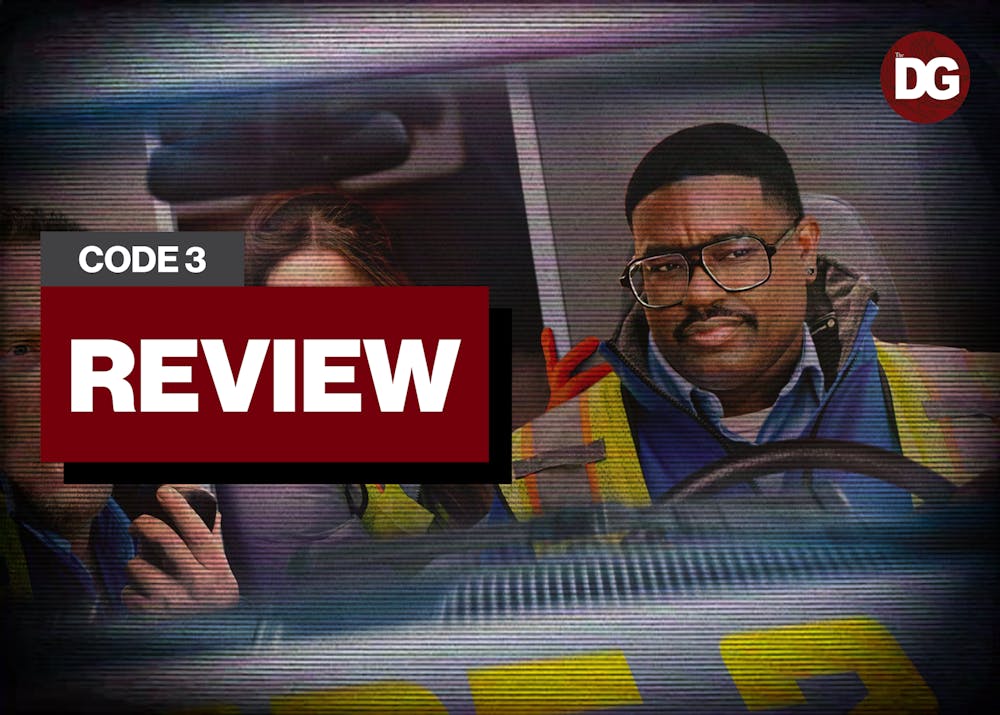Movie: Code 3
Release Date: Sept. 12, 2025
Director: Christopher Leone
Runtime: 1 hour, 44 minutes
Genre: Action/Comedy
Rating: B+

“It’s not medicine, it’s healthcare.”
This line sets the tone in “Code 3”, where Randy (Rainn Wilson), a burned-out paramedic, starts his last 24-hour shift after 18 years on the job. What seems like a routine night quickly spirals into a chaotic, funny and emotional ride through the city.
Randy is tasked with training Jessica (Aimee Carrero), a rookie whose attitude clashes with his deep pessimism. His longtime partner, Mike (Milton "Lil Rel" Howery Jr.), provides stability, but even he struggles with the nonstop demands of the night.
The emergencies come one after another, with absurd calls including a patient who is convinced he's the president, while others are heartbreaking, such as trying to save a child in cardiac arrest. This mix of comedy and tragedy defines the film. Just as the audience laughs at the ridiculous calls, the story quickly pivots to show the life-and-death realities paramedics face.
Director Christopher Leone uses quick pacing and sharp dialogue to keep the tension high; however, not all of the storytelling choices land. Several dialogue cuts are oddly placed, breaking away from the main action to highlight commentary from other first responders in a style that feels more like a documentary.
These moments offer perspective on the profession, but they sometimes interrupt the flow of the narrative. At times, the sudden switches pull viewers out of the urgency of Randy’s shift, making the pacing uneven.
Still, the exchanges add depth to the overall picture. They underline the shared frustrations of paramedics everywhere, including an average salary of $42,060, reinforcing the film’s point about the toll of the job.
Randy and Jessica’s dynamic drives most of the story. Her energy and compassion highlight what Randy has lost after nearly two decades of being worn down by trauma and disrespect.
Their arguments feel real, grounded in the push and pull between idealism and experience. At times, their conversations give the film more emotional weight than the emergencies themselves do.
By the end of his shift, Randy faces a painful truth. The career that shaped his identity also broke him down, leaving him unsure of what comes next.
The film also points to a larger problem. Paramedics are underpaid and overlooked, with this frustration running through Randy’s every move. His run-ins with arrogant doctors and indifferent hospital staff show how the system devalues those who keep it running.
The movie captures the camaraderie among first responders. They use dark humor to cope, including when Randy and Mike tell a group of people at a restaurant that the worst thing they have seen is a baby in a microwave as a "joke."
Wilson’s performance anchors the movie. His natural comedic timing makes the lighter moments land, but he also brings unexpected depth to the more painful scenes. Carrero makes Jessica more than just a bright-eyed trainee, showing vulnerability and resolve as the shift drags on.
Howery adds heart to the trio, with his steady presence balancing the extremes of Randy’s despair and Jessica’s optimism, giving the group an authentic rhythm. The combination of humor and grief feels natural.
“Code 3” works as entertainment, but it also carries a clear message. It challenges audiences to rethink how society treats first responders and to recognize the unseen sacrifices behind every siren.

